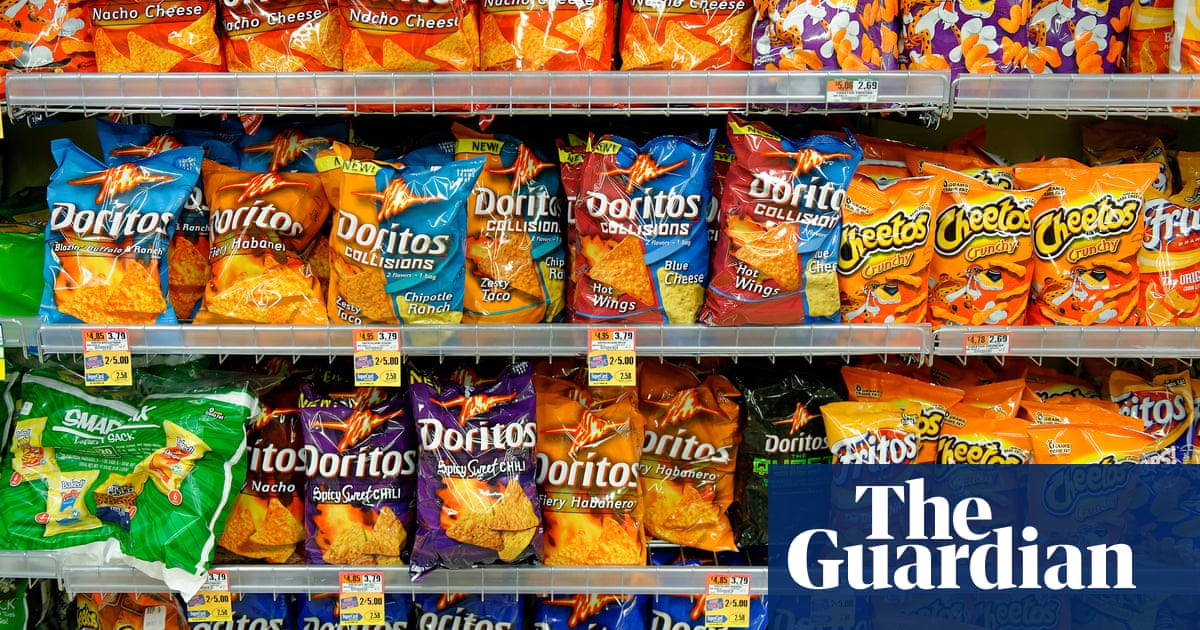Step into a grocery store in France and you’re liable to see a green, yellow or red score on the front of most packaged foods: a green “A” for the healthiest, a red “E” for the least nutritious. Zip across the globe to Chile, and that traffic light-like label becomes a stop sign, warning consumers when a food contains a high amount of sugar, salt, saturated fats or calories.
Today, more than a dozen countries require that companies print nutritional labels on the front of food packages – a move that’s come as the rate of diet-related diseases, like hypertension, type 2 diabetes, heart disease, stroke and obesity, increases worldwide.
So far, the United States does not require any front-of-package nutrition labels. But that could soon change. The US Food and Drug Administration is currently developing front-of-package labels that it could require corporations to begin printing as early as 2027. Despite significant opposition from food companies, many of which are drawing on big tobacco’s playbook, the FDA is evaluating different mandatory label designs to determine which is most effective at informing consumers, but also which is legal under US corporate free speech laws.
As emerging research identifies a wide range of health impacts linked to the consumption of ultra-processed food, conversations about nutritional labels are growing more urgent. To date, the labels under consideration by the FDA (and implemented in other countries) mark only “nutrients of concern”, like sugar and sodium – not-ultra processed foods. But many advocates say that should change.
UPFs are industrially formulated products made out of substances extracted from foods, like sugars, salts, hydrogenated fats, bulking agents and starches (think sugary breakfast cereals, microwave dinners, soft drinks and packaged snacks). Today, UPFs make up 73% of the US food supply, according to Northeastern University’s Network Science Institute, and provide the average US adult with more than 60% of their daily calories. But research is increasingly linking UPFs to a whole host of health issues: from cardiovascular disease and type 2 diabetes to colorectal cancer and depression.
For most of human history, the greatest challenge in the food industry was having enough nutritious and safely preserved food to feed everyone year-round.
“The industrialization of the food supply solved that problem for most of the world, and definitely most of the developed world,” said Amy Bentley, a professor of food studies at New York University.
In the 1970s, many food companies began voluntarily printing nutrition facts on their packages, and the FDA began requiring it in 1993. But, despite the nutrition facts labels, rates of diet-related diseases continued rising.
Today, more than one million people die from diet-related diseases in the US every year. So, in 2006, the Center for Science in the Public Interest (or CSPI), a non-profit watchdog and consumer advocacy group focused on food policy, filed a citizen petition with the FDA, asking the agency to require a front-of-package label. The idea was that the current nutrition-facts label on the backs of packages was both unclear and easy to ignore – it required a high level of math and nutritional knowledge to interpret and was hidden out of sight.
The FDA never formally responded to that petition, but did ask the non-profit Institute of Medicine (today known as the National Academy of Medicine) to study front-of-package nutrition labeling. In 2010 and again in 2012, the institute released reports recommending those labels. In a move that labeling advocates suspect was designed to pre-empt mandatory labeling requirements, two food industry trade groups developed a voluntary front-of-package label called Facts Up Front.
Those labels, which are now featured on products from Cheerios to boxed mac and cheese, include the grams and percentage daily values for both nutrients of concern, like sugar and salt, and those that are important for our health, like fiber and potassium. Although Facts Up Front did move important nutrition facts to the fronts of food packages, labeling advocates point out that the label is still difficult to interpret.
As Facts Up Front appeared in the US, nutrition advocates in Latin America were developing a different labeling system. In 2016, Chile introduced the first nutritional warning label in the world – a black, stop sign-shaped label that companies were required to add if a food exceeded a high enough threshold of sugar, salt, saturated fat or calories. Researchers across the region had determined that the most effective nutritional labels were those that interpreted information for consumers (for example, saying “high in sodium” or “excess sodium”, instead of “570mg sodium”) and used icons. In quick succession, Peru, Uruguay, Mexico, Argentina and Colombia began rolling out similar warning labels.
“People really do struggle in the real world to interpret percent daily value,” says Marissa G Hall, a professor of health behavior at the University of North Carolina at Chapel Hill’s Gillings School of Global Public Health. “Front-of-package labels are this huge opportunity to really level the playing field and make that information more accessible.”
In August 2022, CSPI filed a new citizen petition with the FDA to have the agency require front-of-package labeling – and the FDA is currently studying different labels it may soon mandate or recommend companies print.
Although research shows that a “high in” label is most effective, a traffic light-like label (now popular across much of Europe) is also under consideration. But, in the US, commercial speech is protected under the first amendment (although supreme court rulings have found that the government can compel corporations to share “purely factual and uncontroversial information”). Because of that, it’s unlikely that the FDA will require corporations to print a stop sign (essentially saying “Don’t eat this!”) or denote which foods are ultra processed (a still-emerging area of scientific debate).
Labels “should not raise unnecessary fear in consumers through health warnings and symbols or otherwise promote the avoidance of food ingredients or additives that have been affirmed safe by federal regulatory bodies”, two industry trade groups – the Consumer Brands Association and the Food Industry Association, which run the voluntary Facts Up Front program – wrote in a 2022 public comment to the FDA.
“We are concerned that interpretive systems, such as a red/green light system, will raise unnecessary fear in consumers based on a single limiter nutrient without providing meaningful information as to how that food item might fit into overall healthy eating patterns,” they continued, adding that the agency should focus on educating consumers on the existing nutrition-facts panel and working within the Facts Up Front framework.
Labeling advocates are critical of that approach. “The food industry is drawing heavily on the same playbook that the tobacco industry used to oppose regulation. And one of the things that they love to do is propose self-regulation,” said Lindsey Smith Taillie, a professor of nutrition also at UNC Chapel Hill’s Gillings School of Global Public Health. “It’s their way of getting a labeling system without having any meaningful consequences.”
“We know people, especially parents, really do want to make healthier choices for their kids,” said Hall. “I like to think of labels as not the sort of authoritarian policy that’s telling you you could never eat this kind of cereal again. I think it’s really providing information to consumers that they want to have and deserve to have.”
The FDA was scheduled to publish an initial labeling rule in December 2023, but pushed its own deadline to June 2024. If it happens then, the FDA will send the rule to the White House, where the Office of Management and Budget will determine whether to release the rule for public comment before finalizing it.
“That’s a really critical stage because that’s when the food industry is going to start meeting not just with the FDA, but with the White House and saying: ‘Maybe you should hold onto this, not publish it so close to an election,’” said Eva Greenthal, a CSPI senior policy scientist.
The outcome of the elections could alter the course of labeling dramatically. If Donald Trump wins, the FDA will likely freeze labeling efforts. Meanwhile, if Biden wins, the FDA will likely proceed on schedule – issuing a final rule, and then a compliance deadline for big corporations and small businesses to begin printing labels (typically two to three years). When the FDA releases a rule, food companies and trade associations will likely sue the agency for infringing on their first amendment rights – which could draw out the rollout of new labels even longer.
“Regardless of whether Republicans or Democrats are in the White House or hold the Senate or the House, the food industry is going to try to delay the process and deny the science and influence lawmakers and regulators along the way,” said Greenthal.
That delay tactic – like self-regulation – comes straight from the tobacco industry. And many food industry executives aren’t just looking at the tobacco-industry playbook from a distance – they were involved in creating it.
“A lot of the CEOs and the executives, they have moved on from tobacco and they now work in food,” said Eric Crosbie, a professor of behavioral health and health administration and policy at the University of Nevada, Reno. He points to Kraft Foods, which was owned by Philip Morris USA, the maker of Marlboro cigarettes, and Nabisco, which was owned by RJ Reynolds, the maker of Camels – and notes a 2023 study that found that tobacco companies distributed the most hyper-palatable foods on the market.
The US has been trying to compel corporations to print graphic images (photographs or drawings, not just text) on cigarette packages since 2009. When people wonder why the country doesn’t have more rigorous food labels, Crosbie points to that. “Well, just look at tobacco,” he said. “Thirteen years of a delay because of the first amendment” and its provisions for corporations.
Last year, food-labeling advocates organized to introduce two bills into Congress: the Truth in Labeling act and the Food Labeling Modernization act. If either passed the legislature, it could entirely bypass the FDA timeline. But that’s unlikely with Republicans controlling the House.
Even if the FDA does require food companies to print mandatory, interpretive labels, there’s still the evolving issue of ultra-processed foods.
Taillie and her colleagues at the University of North Carolina are testing an ultra-processed food label, and they hope that research might guide future efforts to label UPFs as our understanding of their health impacts deepens.
But Xaq Frohlich, a history professor at Auburn University and author of the book From Label to Table: Regulating Food in America in the Information Age, isn’t so sure the FDA would consider an “ultra-processed” label. He points to the agency’s regulation of genetically modified food, when it decided that it didn’t matter whether a plant had been modified, so long as the food it produced was not. One of the arguments the FDA made then, he remembers, was “we focus on the product, not the process”. If that’s still the case, ultra processed or unprocessed may not matter to the agency.
Another way to tackle the presence of UPFs in our food system would be for the US Department of Agriculture and the Department of Health and Human Services to issue a recommendation on ultra-processed foods in the US Dietary Guidelines for Americans, which are updated every five years and due to be revised in 2025. Those guidelines form the basis for all federal food policies, from the labeling requirements that the FDA issues to school meals, the Supplemental Nutrition Assistance Program (SNAP), the Women, Infants and Children supplemental nutrition program (WIC) and other programs. All of this helps to explain why Americans with lower incomes eat the most ultra-processed food.
Although the 2025 dietary guidelines advisory committee has been tasked with evaluating research related to ultra-processed foods, it’s unclear what they’ll recommend – and whether the guidelines will actually include their recommendations. In 2022, Crosbie published a study that found that 95% of the members of the 2020 dietary guidelines committee had conflicts of interest with the food or pharmaceutical industries.
If the dietary guidelines committee addresses ultra-processed foods, “it would go a long way to trickling into policy”, said Jennifer Pomeranz, a public health lawyer and professor at New York University. “That doesn’t have to be the chronology of it, though. It could happen in other ways.” She points to a bill the Massachusetts state legislature debated, but failed to pass, in 2021 which would have limited the amount of ultra processed food served in schools.
Though there are powerful and immediate regulatory actions the federal government could take to address heightened consumption of ultra-processed foods, weaning ourselves from them entirely may require examining the forces – industrialization, poverty, unpaid domestic labor and agriculture policy – that made them so tantalizing in the first place.
Read more from this series:



